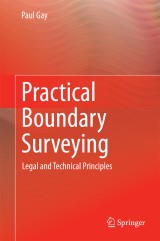Details

Practical Boundary Surveying
Legal and Technical Principles|
117,69 € |
|
| Verlag: | Springer |
| Format: | |
| Veröffentl.: | 01.11.2014 |
| ISBN/EAN: | 9783319071589 |
| Sprache: | englisch |
Dieses eBook enthält ein Wasserzeichen.
Beschreibungen
This complete guide to boundary surveying provides landowners, land surveyors and students with the necessary foundation to understand boundary surveying techniques and the common legal issues that govern boundary establishment. Far from a simple engineering function, boundary establishment is often a difficult and delicate matter, with real monetary and legal ramifications if not accomplished accurately. This book helps readers to understand why such challenges exist and what remedies may be available. Using only simple and logically explained mathematics, the principles and practice of boundary surveying are demystified for those without prior experience and the focused coverage of pivotal issues such as easements and setting lot corners will aid even licensed practitioners in untangling thorny cases. Practical advice on using both basic and advanced instruments is included, alongside clear explanations of legal regulations that will impact any surveyor’s work. For those who desire a more in-depth treatment of the mathematical aspects of boundary surveying, the Appendix includes the underlying theory and many examples of typical calculations performed by boundary surveyors.
Getting Started.- Basic Legal Concepts.- Basic Technical Concepts.- Surveying Instruments.- Road Geometry.- The Public Land Survey System.- Making a Boundary Survey.- Boundary Survey Research.- Starting Field Work.- Field Work – Finding Monuments.- Field Work – Traversing.- Water Boundaries.- Calculations.- Setting Lot Corners.- Survey Plans.- Unwritten Titles.- Easements.
Paul L. Gay is an attorney and licensed land surveyor with 35 years of experience in the field. Mr. Gay has taught in the Engineering Division at Bristol Community College. He has developed and taught a course on wind power under a grant from the National Science Foundation. He is developing a new Land Surveying legal course under a grant from the Massachusetts Association of Land Surveyors and Civil Engineers. He currently specializes primarily in boundary surveying, with a special interest in boundary dispute resolution. Mr. Gay has served as an expert witness in many trials involving land and boundary issues from Massachusetts and Rhode Island to Alaska. He has written books and articles on surveying, geology, local history and wind power, as well as Survey, a computer program for surveying calculations, Metrology, a Windows units conversion program, and Tide, a program for calculating tides for any date at many U.S. coastal locations. He is also President of Solar Star Energy Inc. which sites and installs photovoltaic solar systems. Due to his expertise in designing wind turbines, controls for wind power systems, and land use and siting, his unique skill-set makes him a sought-after resource for businesses and individuals exploring the option of adding renewable energy installations to their properties. Mr. Gay holds a B.S. degree in sociology from the University of Massachusetts, a ScM degree in geological sciences from Brown University and a J.D. degree from New England School of Law.
<p>This guide to boundary surveying provides landowners, land surveyors, students and others with the necessary foundation to understand boundary surveying techniques and the common legal issues that govern boundary establishment. Boundary surveying is sometimes mistakenly considered a strictly technical discipline with simple and straightforward technical solutions. In reality, boundary establishment is often a difficult and complex matter, requiring years of experience and a thorough understanding of boundary law. This book helps readers to understand the challenges often encountered by boundary surveyors and some of the available solutions. Using only simple and logically explained mathematics, the principles and practice of boundary surveying are demystified for those without prior experience, and the focused coverage of pivotal issues such as easements and setting lot corners will aid even licensed practitioners in untangling thorny cases. Practical advice on using both basic and advanced instruments is included, alongside clear explanations of the legal elements that impact boundary establishment. Because many modern surveys are resurveys of existing boundaries, which may have been created a century or more ago, this book discusses the historical techniques of boundary surveying so the modern surveyor will understand how to follow in the footsteps of the original surveyor. For those who desire a more in-depth treatment of the mathematical aspects of boundary surveying, the Appendix includes the underlying theory and many examples of typical calculations performed by boundary surveyors.</p>
Combines science, engineering and legal information to provide a complete practical guide to boundary surveying Covers the most important technological advances in the field, such as GIS and GPS, as well as laser and optical tools Teaches readers to understand and correctly apply legal rules for boundary establishment, saving years of trial and error in the field Appendices include all necessary mathematical equations and worked examples Includes supplementary material: sn.pub/extras
Diese Produkte könnten Sie auch interessieren:

Water Quality Hazards and Dispersion of Pollutants

von: Wlodzimierz Czernuszenko, Pawel Rowinski

149,79 €















